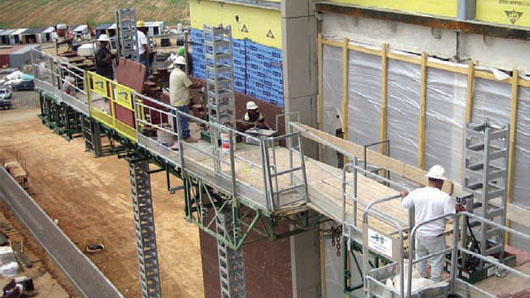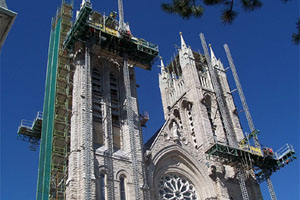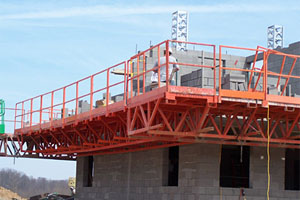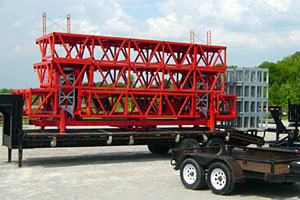March 9, 2009 7:40 AM CDT

Mast climbers are becoming indispensible to the commercial masonry industry, says Michael Solomon, national sales manager for the Columbus, Ohio-based companies TNT Equipment Co. and Premier Scaffold Solutions (exclusive North America distributors of the new Pro-Series mast climber that's manufactured by Atlanta-based Hydek).
"We're getting to the point that, if you're a commercial masonry contractor, you need a mast climber," he says.
Solomon estimates that about 40 percent of masonry contractors working on commercial jobs use mast climbers.

World of Concrete was the site of the launch of the Pro-Series, a mast climber that offers a 20,000-pound capacity with a 13-horsepower electric start engine and a 35-foot freestanding height.
"These machines can have a single unit go as wide as 64 feet or, in a twin configuration, as wide as 148 feet, not to mention the ability in handling corner bridging and forward extensions of up to 20 feet in front of the deck," Solomon says. "What's new about our mast climber is we can do wider linear feet per a single unit. We also offer different configurations for bridging and going around corners."
The Pro-Series reduces the number of pieces needed to make the scaffolding versatile.
"We have less pieces that create more solutions," Solomon says. "A masonry contractor can buy fewer pieces, because the pieces have a higher utilization. The end-user doesn't have to have a million pieces for bridging and corner configurations."
Also new is the E-series from Hydro Mobile in Quebec, Canada. "The E-series is our electric model. It's the first electric model for Hydro Mobile," says Thierry LaChapelle, marketing director.
The E-series climbs up to 250 feet, has a 39-foot work platform, and offers a 5,800-pound weight capacity. It also features forward and back extensions, and swivel bridges for a wide range of configurations.
"E-Series is a light- and medium-duty mast climber which combines low ownership and rental costs with versatility," LaChapelle says, adding that the mast climber works great for small-scale repair and restoration work.

Most manufacturers provide mast climber training programs. Hydro Mobile University offers three-day seminars on proper installation, operation and transportation of the company's mast climbers.
"A mast climber is by far the safest scaffolding," LaChapelle says. "Most accidents are caused by a lack of training."
Contractors need to be trained to gain maximum productivity, he says. "You gain over 30 percent productivity [with mast climbers]. You don't need to move planks, and you're working at the ideal height."
TNT Equipment and Premier Scaffold have a free training program that teaches how to set up and use mast climbers.
"Mast climbers have made this industry tremendously safe, if you follow the manufacturers' standards," Solomon says. "The mason can't walk off the end of the scaffold. We have all of the guard rails built in for safety."
The wide platforms hold a lot of weight, which lets masonry contractors set brick or block on the scaffold where laborers can easily reach it, he says. "The deck is 7 feet wide, which is a lot more space for holding material. There's a lot of room for laborers to move around."
Columbia, Tenn.-based EZ Scaffold has sliding gates, so no one has to stand next to an opening.
"If the scaffold is assembled correctly, they are enclosed platforms from the ground to the top of wall," says Clint Bridges, EZ Scaffold VP. "There are no boards to jump or platforms to reconfigure. The top safety rail, mid-safety rail, and toe boards are all built in."
Even though mast climbers are easy to set up and use, contractors need to follow through on training, he says. "If the scaffold is not ready when the mason needs it, profits are lost. If it is not set up and used properly, lives are lost."

Mast climbers require less labor to assemble and move, eliminating down time.
"The main reason contractors are moving toward mast climbers is they are money making machines," Bridges says. "Mast climbers can be set up and moved twice as fast as crank up with half the labor."
One or two people can set up a mast climber 72 feet long X 40 feet high, straight off the truck, in less than an hour and move it in less than 45 minutes, he says.
Labor on the scaffold is reduced by at least 30 percent, since there are no boards to raise or winches to crank, Bridges says. "All the laborer has to do is keep the mason stocked, and this is easy on a metal deck with no board lap. The labor feels safer and is more productive."
LaChapelle agrees, noting that mast climbers can pay for themselves within 18 to 24 months because of reduced labor.
"Instead of one laborer per mason, you can have two laborers per three masons," he says.
Mast climbers let masons work between waist and chest level, where they can lay 25 percent more product because of better ergonomics. "They're working at their ideal height and not stressing their bodies," Solomon says, who points out that raising mast climbers requires less work than other scaffolding.
"With crank up scaffolding, you have to have someone crank it up every seven to 10 feet on a wall," Solomon says. "With the Pro Series, one guy is able to lift 160 feet of scaffolding by himself."
Two people can erect 100 feet of Pro-Series scaffold in just a couple of hours, he says. "Now you can save labor with set up, which gets your production up because you have the guys working on the wall right away."
The Mast Climber Advantage
How these money-making machines offer unrivaled benefits that increase profits
By Brett Martin

Mast climbers are becoming indispensible to the commercial masonry industry. Photo courtesy of Hydro Mobile.
Mast climbers are becoming indispensible to the commercial masonry industry, says Michael Solomon, national sales manager for the Columbus, Ohio-based companies TNT Equipment Co. and Premier Scaffold Solutions (exclusive North America distributors of the new Pro-Series mast climber that's manufactured by Atlanta-based Hydek).
"We're getting to the point that, if you're a commercial masonry contractor, you need a mast climber," he says.
Solomon estimates that about 40 percent of masonry contractors working on commercial jobs use mast climbers.
New Mast Climbers Bring Benefits

The E-series from Hydro Mobile climbs up to 250 feet, has a 39-foot work platform, and offers a 5,800-pound weight capacity. Photo courtesy of Hydro Mobile.
"These machines can have a single unit go as wide as 64 feet or, in a twin configuration, as wide as 148 feet, not to mention the ability in handling corner bridging and forward extensions of up to 20 feet in front of the deck," Solomon says. "What's new about our mast climber is we can do wider linear feet per a single unit. We also offer different configurations for bridging and going around corners."
The Pro-Series reduces the number of pieces needed to make the scaffolding versatile.
"We have less pieces that create more solutions," Solomon says. "A masonry contractor can buy fewer pieces, because the pieces have a higher utilization. The end-user doesn't have to have a million pieces for bridging and corner configurations."
Also new is the E-series from Hydro Mobile in Quebec, Canada. "The E-series is our electric model. It's the first electric model for Hydro Mobile," says Thierry LaChapelle, marketing director.
The E-series climbs up to 250 feet, has a 39-foot work platform, and offers a 5,800-pound weight capacity. It also features forward and back extensions, and swivel bridges for a wide range of configurations.
"E-Series is a light- and medium-duty mast climber which combines low ownership and rental costs with versatility," LaChapelle says, adding that the mast climber works great for small-scale repair and restoration work.
Safety First

EZ Scaffold has sliding gates, so no one has to stand next to an opening. Photo courtesy of EZ Scaffold.
"A mast climber is by far the safest scaffolding," LaChapelle says. "Most accidents are caused by a lack of training."
Contractors need to be trained to gain maximum productivity, he says. "You gain over 30 percent productivity [with mast climbers]. You don't need to move planks, and you're working at the ideal height."
TNT Equipment and Premier Scaffold have a free training program that teaches how to set up and use mast climbers.
"Mast climbers have made this industry tremendously safe, if you follow the manufacturers' standards," Solomon says. "The mason can't walk off the end of the scaffold. We have all of the guard rails built in for safety."
The wide platforms hold a lot of weight, which lets masonry contractors set brick or block on the scaffold where laborers can easily reach it, he says. "The deck is 7 feet wide, which is a lot more space for holding material. There's a lot of room for laborers to move around."
Columbia, Tenn.-based EZ Scaffold has sliding gates, so no one has to stand next to an opening.
"If the scaffold is assembled correctly, they are enclosed platforms from the ground to the top of wall," says Clint Bridges, EZ Scaffold VP. "There are no boards to jump or platforms to reconfigure. The top safety rail, mid-safety rail, and toe boards are all built in."
Even though mast climbers are easy to set up and use, contractors need to follow through on training, he says. "If the scaffold is not ready when the mason needs it, profits are lost. If it is not set up and used properly, lives are lost."
Less Labor, More Money

Mast climbers require less labor to assemble and move, eliminating down time. Photo courtesy of EZ Scaffold.
"The main reason contractors are moving toward mast climbers is they are money making machines," Bridges says. "Mast climbers can be set up and moved twice as fast as crank up with half the labor."
One or two people can set up a mast climber 72 feet long X 40 feet high, straight off the truck, in less than an hour and move it in less than 45 minutes, he says.
Labor on the scaffold is reduced by at least 30 percent, since there are no boards to raise or winches to crank, Bridges says. "All the laborer has to do is keep the mason stocked, and this is easy on a metal deck with no board lap. The labor feels safer and is more productive."
LaChapelle agrees, noting that mast climbers can pay for themselves within 18 to 24 months because of reduced labor.
"Instead of one laborer per mason, you can have two laborers per three masons," he says.
Mast climbers let masons work between waist and chest level, where they can lay 25 percent more product because of better ergonomics. "They're working at their ideal height and not stressing their bodies," Solomon says, who points out that raising mast climbers requires less work than other scaffolding.
"With crank up scaffolding, you have to have someone crank it up every seven to 10 feet on a wall," Solomon says. "With the Pro Series, one guy is able to lift 160 feet of scaffolding by himself."
Two people can erect 100 feet of Pro-Series scaffold in just a couple of hours, he says. "Now you can save labor with set up, which gets your production up because you have the guys working on the wall right away."
About the Author
Brett Martin is a freelance writer located in Shakopee, Minn. with several years of construction and writing experience.


















